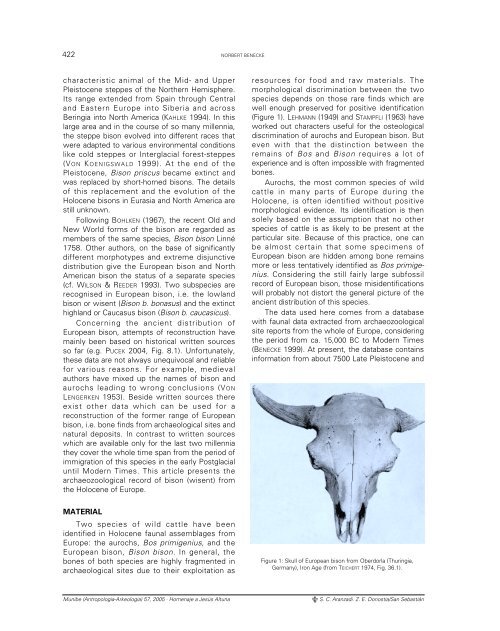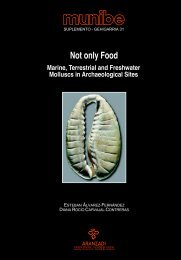The Holocene distribution of European bison – the ... - Aranzadi
The Holocene distribution of European bison – the ... - Aranzadi
The Holocene distribution of European bison – the ... - Aranzadi
You also want an ePaper? Increase the reach of your titles
YUMPU automatically turns print PDFs into web optimized ePapers that Google loves.
422 NORBERT BENECKE<br />
characteristic animal <strong>of</strong> <strong>the</strong> Mid- and Upper<br />
Pleistocene steppes <strong>of</strong> <strong>the</strong> Nor<strong>the</strong>rn Hemisphere.<br />
Its range extended from Spain through Central<br />
and Eastern Europe into Siberia and across<br />
Beringia into North America (KAHLKE 1994). In this<br />
large area and in <strong>the</strong> course <strong>of</strong> so many millennia,<br />
<strong>the</strong> steppe <strong>bison</strong> evolved into different races that<br />
were adapted to various environmental conditions<br />
like cold steppes or Interglacial forest-steppes<br />
(VON KOENIGSWALD 1999). At <strong>the</strong> end <strong>of</strong> <strong>the</strong><br />
Pleistocene, Bison priscus became extinct and<br />
was replaced by short-horned <strong>bison</strong>s. <strong>The</strong> details<br />
<strong>of</strong> this replacement and <strong>the</strong> evolution <strong>of</strong> <strong>the</strong><br />
<strong>Holocene</strong> <strong>bison</strong>s in Eurasia and North America are<br />
still unknown.<br />
Following BOHLKEN (1967), <strong>the</strong> recent Old and<br />
New World forms <strong>of</strong> <strong>the</strong> <strong>bison</strong> are regarded as<br />
members <strong>of</strong> <strong>the</strong> same species, Bison <strong>bison</strong> Linné<br />
1758. O<strong>the</strong>r authors, on <strong>the</strong> base <strong>of</strong> significantly<br />
different morphotypes and extreme disjunctive<br />
<strong>distribution</strong> give <strong>the</strong> <strong>European</strong> <strong>bison</strong> and North<br />
American <strong>bison</strong> <strong>the</strong> status <strong>of</strong> a separate species<br />
(cf. WILSON & REEDER 1993). Two subspecies are<br />
recognised in <strong>European</strong> <strong>bison</strong>, i.e. <strong>the</strong> lowland<br />
<strong>bison</strong> or wisent (Bison b. bonasus) and <strong>the</strong> extinct<br />
highland or Caucasus <strong>bison</strong> (Bison b. caucasicus).<br />
Concerning <strong>the</strong> ancient <strong>distribution</strong> <strong>of</strong><br />
<strong>European</strong> <strong>bison</strong>, attempts <strong>of</strong> reconstruction have<br />
mainly been based on historical written sources<br />
so far (e.g. PUCEK 2004, Fig. 8.1). Unfortunately,<br />
<strong>the</strong>se data are not always unequivocal and reliable<br />
for various reasons. For example, medieval<br />
authors have mixed up <strong>the</strong> names <strong>of</strong> <strong>bison</strong> and<br />
aurochs leading to wrong conclusions (VON<br />
LENGERKEN 1953). Beside written sources <strong>the</strong>re<br />
exist o<strong>the</strong>r data which can be used for a<br />
reconstruction <strong>of</strong> <strong>the</strong> former range <strong>of</strong> <strong>European</strong><br />
<strong>bison</strong>, i.e. bone finds from archaeological sites and<br />
natural deposits. In contrast to written sources<br />
which are available only for <strong>the</strong> last two millennia<br />
<strong>the</strong>y cover <strong>the</strong> whole time span from <strong>the</strong> period <strong>of</strong><br />
immigration <strong>of</strong> this species in <strong>the</strong> early Postglacial<br />
until Modern Times. This article presents <strong>the</strong><br />
archaeozoological record <strong>of</strong> <strong>bison</strong> (wisent) from<br />
<strong>the</strong> <strong>Holocene</strong> <strong>of</strong> Europe.<br />
resources for food and raw materials. <strong>The</strong><br />
morphological discrimination between <strong>the</strong> two<br />
species depends on those rare finds which are<br />
well enough preserved for positive identification<br />
(Figure 1). LEHMANN (1949) and STAMPFLI (1963) have<br />
worked out characters useful for <strong>the</strong> osteological<br />
discrimination <strong>of</strong> aurochs and <strong>European</strong> <strong>bison</strong>. But<br />
even with that <strong>the</strong> distinction between <strong>the</strong><br />
remains <strong>of</strong> Bos and Bison requires a lot <strong>of</strong><br />
experience and is <strong>of</strong>ten impossible with fragmented<br />
bones.<br />
Aurochs, <strong>the</strong> most common species <strong>of</strong> wild<br />
cattle in many parts <strong>of</strong> Europe during <strong>the</strong><br />
<strong>Holocene</strong>, is <strong>of</strong>ten identified without positive<br />
morphological evidence. Its identification is <strong>the</strong>n<br />
solely based on <strong>the</strong> assumption that no o<strong>the</strong>r<br />
species <strong>of</strong> cattle is as likely to be present at <strong>the</strong><br />
particular site. Because <strong>of</strong> this practice, one can<br />
be almost certain that some specimens <strong>of</strong><br />
<strong>European</strong> <strong>bison</strong> are hidden among bone remains<br />
more or less tentatively identified as Bos primigenius.<br />
Considering <strong>the</strong> still fairly large subfossil<br />
record <strong>of</strong> <strong>European</strong> <strong>bison</strong>, those misidentifications<br />
will probably not distort <strong>the</strong> general picture <strong>of</strong> <strong>the</strong><br />
ancient <strong>distribution</strong> <strong>of</strong> this species.<br />
<strong>The</strong> data used here comes from a database<br />
with faunal data extracted from archaeozoological<br />
site reports from <strong>the</strong> whole <strong>of</strong> Europe, considering<br />
<strong>the</strong> period from ca. 15,000 BC to Modern Times<br />
(BENECKE 1999). At present, <strong>the</strong> database contains<br />
information from about 7500 Late Pleistocene and<br />
MATERIAL<br />
Two species <strong>of</strong> wild cattle have been<br />
identified in <strong>Holocene</strong> faunal assemblages from<br />
Europe: <strong>the</strong> aurochs, Bos primigenius, and <strong>the</strong><br />
<strong>European</strong> <strong>bison</strong>, Bison <strong>bison</strong>. In general, <strong>the</strong><br />
bones <strong>of</strong> both species are highly fragmented in<br />
archaeological sites due to <strong>the</strong>ir exploitation as<br />
Figure 1: Skull <strong>of</strong> <strong>European</strong> <strong>bison</strong> from Oberdorla (Thuringia,<br />
Germany), Iron Age (from TEICHERT 1974, Fig. 36.1).<br />
Munibe (Antropologia-Arkeologia) 57, 2005 · Homenaje a Jesús Altuna<br />
S. C. <strong>Aranzadi</strong>. Z. E. Donostia/San Sebastián
















